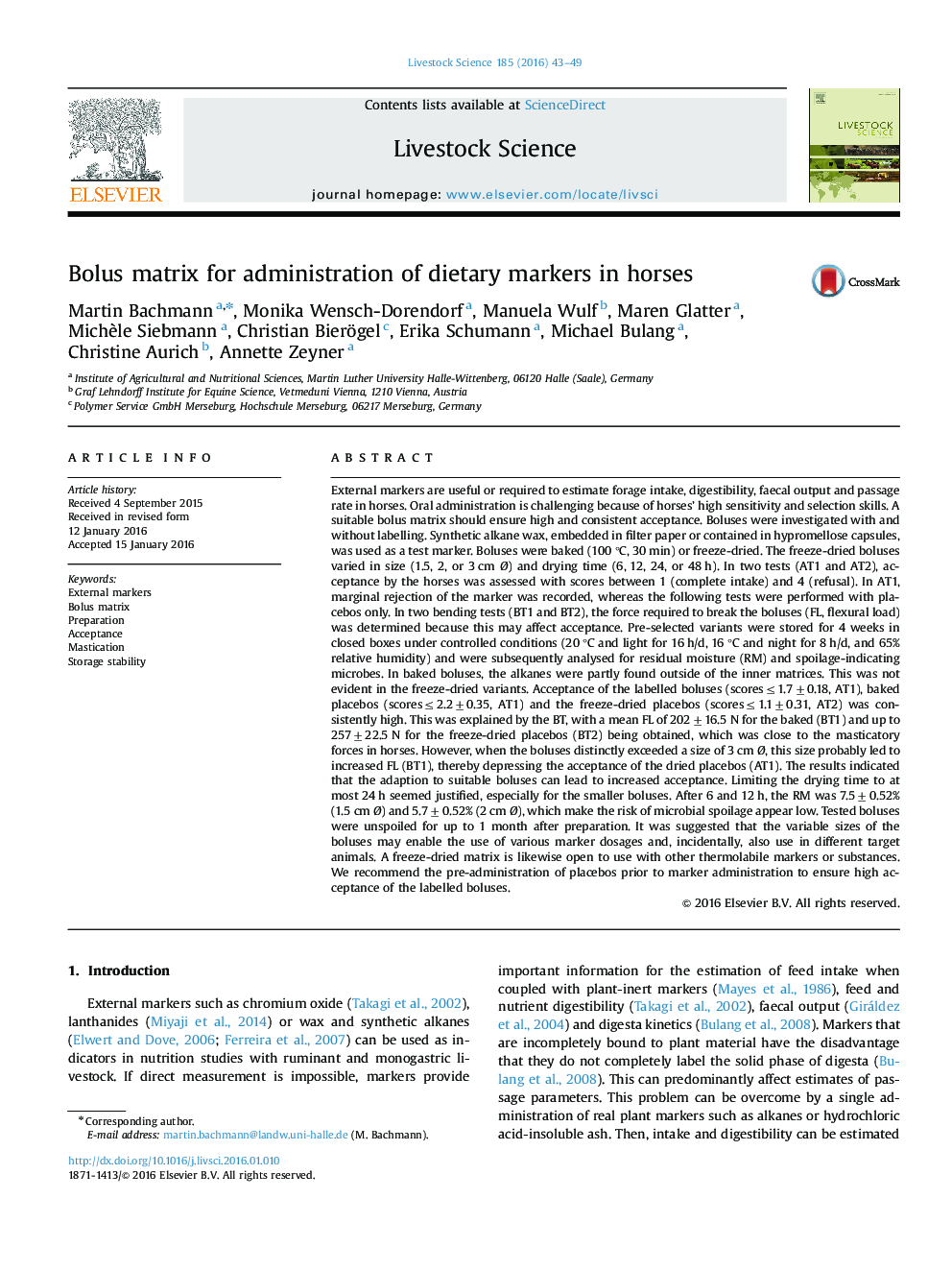| کد مقاله | کد نشریه | سال انتشار | مقاله انگلیسی | نسخه تمام متن |
|---|---|---|---|---|
| 2446939 | 1553947 | 2016 | 7 صفحه PDF | دانلود رایگان |
عنوان انگلیسی مقاله ISI
Bolus matrix for administration of dietary markers in horses
ترجمه فارسی عنوان
ماتریس بولوس برای استفاده از نشانگرهای رژیم غذایی در اسب ها
دانلود مقاله + سفارش ترجمه
دانلود مقاله ISI انگلیسی
رایگان برای ایرانیان
کلمات کلیدی
نشانگرهای خارجی، ماتریس بولوس، آماده سازی، پذیرش، چسباندن، پایداری ذخیره سازی،
موضوعات مرتبط
علوم زیستی و بیوفناوری
علوم کشاورزی و بیولوژیک
علوم دامی و جانورشناسی
چکیده انگلیسی
External markers are useful or required to estimate forage intake, digestibility, faecal output and passage rate in horses. Oral administration is challenging because of horses' high sensitivity and selection skills. A suitable bolus matrix should ensure high and consistent acceptance. Boluses were investigated with and without labelling. Synthetic alkane wax, embedded in filter paper or contained in hypromellose capsules, was used as a test marker. Boluses were baked (100 °C, 30 min) or freeze-dried. The freeze-dried boluses varied in size (1.5, 2, or 3 cm Ã) and drying time (6, 12, 24, or 48 h). In two tests (AT1 and AT2), acceptance by the horses was assessed with scores between 1 (complete intake) and 4 (refusal). In AT1, marginal rejection of the marker was recorded, whereas the following tests were performed with placebos only. In two bending tests (BT1 and BT2), the force required to break the boluses (FL, flexural load) was determined because this may affect acceptance. Pre-selected variants were stored for 4 weeks in closed boxes under controlled conditions (20 °C and light for 16 h/d, 16 °C and night for 8 h/d, and 65% relative humidity) and were subsequently analysed for residual moisture (RM) and spoilage-indicating microbes. In baked boluses, the alkanes were partly found outside of the inner matrices. This was not evident in the freeze-dried variants. Acceptance of the labelled boluses (scoresâ¤1.7±0.18, AT1), baked placebos (scoresâ¤2.2±0.35, AT1) and the freeze-dried placebos (scoresâ¤1.1±0.31, AT2) was consistently high. This was explained by the BT, with a mean FL of 202±16.5 N for the baked (BT1) and up to 257±22.5 N for the freeze-dried placebos (BT2) being obtained, which was close to the masticatory forces in horses. However, when the boluses distinctly exceeded a size of 3 cm Ã, this size probably led to increased FL (BT1), thereby depressing the acceptance of the dried placebos (AT1). The results indicated that the adaption to suitable boluses can lead to increased acceptance. Limiting the drying time to at most 24 h seemed justified, especially for the smaller boluses. After 6 and 12 h, the RM was 7.5±0.52% (1.5 cm Ã) and 5.7±0.52% (2 cm Ã), which make the risk of microbial spoilage appear low. Tested boluses were unspoiled for up to 1 month after preparation. It was suggested that the variable sizes of the boluses may enable the use of various marker dosages and, incidentally, also use in different target animals. A freeze-dried matrix is likewise open to use with other thermolabile markers or substances. We recommend the pre-administration of placebos prior to marker administration to ensure high acceptance of the labelled boluses.
ناشر
Database: Elsevier - ScienceDirect (ساینس دایرکت)
Journal: Livestock Science - Volume 185, March 2016, Pages 43-49
Journal: Livestock Science - Volume 185, March 2016, Pages 43-49
نویسندگان
Martin Bachmann, Monika Wensch-Dorendorf, Manuela Wulf, Maren Glatter, Michèle Siebmann, Christian Bierögel, Erika Schumann, Michael Bulang, Christine Aurich, Annette Zeyner,
